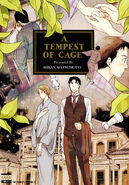This article is the master list of Bara, Shounen-ai and Yaoi manga, of which the format generally consists of black and white images used to relay story events. Speech bubbles with text that is read right to left is also a feature. Manga has decisively helped establish yaoi as it is. From their release in recent decades, where there may be a few published each year, the total number of yaoi manga is nearing the ten thousand mark. Even with other formats, the vast majority of yaoi series are detailed in manga, where increasing amounts are being released.
The list of yaoi manga is in alphabetical order and begins with A , before descending down to Z. Series with titles that begin with numbers conclude the list. The manga category is also available to view.
Details on Yaoi Manga[]
Foundations[]
Yaoi, along with bara and shounen-ai originates from Japan where related stories are depicted in often printed materials. The author and illustrator of a manga is known as a mangaka. Stories featuring males in relationships were depicted in manga before Chinese manhua and South Korean manhwa followed suit. Manga continues to be physically published even with the advent of online releases such as webtoons. Where the lack of color printing was done to save on publishing costs, manga even when released online retains its distinct signature black and white style artwork where other formats have embraced vibrant coloration in their works.
Compared to other works, manga can be characterized by what could be regarded as select numbers of chapters and volumes. A manga with five chapters in one volume could have many pages within each chapter. Where one manga chapter could consist of fifty pages, and a manhwa chapter could be complete at ten pages, accordingly there may be a similar amount of materials in a five chapter manga as a one hundred chapter webtoon depending on the specific series. As with any piece, chapter numbers are not an indication of the length, or story depth of a work. With the chapter numbers and release dates for each one, a manga can be completed within the year as Cupid ni Rakurai was where the thirteen chapters and three extras were released from February to August 2017. Although there are not as many in comparison, some series such as Kusatta Kyoushi no Houteishiki can take place over forty seven chapters, within ten volumes, from 1993 to 2002.
Manga is very often the foundation of other formats, a story can be adapted into a drama CD for the character voices to be heard as story events take place. Even with other formats such as webtoons, the great majority of anime are adaptions of manga specifically. A manga can also be adapted into a solely text release as with a light novel, and likewise novels can be adapted into manga.
Genres[]
Originating from shōjo manga which was aimed towards girls, yaoi became a genre in its own right. As with shounen-ai and bara, this type of classification is marketing based where a specific audience is targeted. Yaoi manga may denote male relationships, but these scenarios take place in genres as they are understood. Stories can be fantasy, historical, to psychological among various other world indicating genres.
Types of Manga[]
Chapters may be serialized one at a time by manga publishing organizations, where Emerald is an example of one. A series could have one chapter released at the start of each month, where each one would be released with individual chapters from other series. Readers would view an anthology featuring the latest chapters from multiple different series. Individual chapters of Kimi ni wa Todokanai. were serialized in Gene pixiv along with chapters from different manga stories. Five different series could have each new chapter collected into such an anthology. After chapters have been released, those from an individual series can be collected into volumes, or tankōbon. In 2013 chapters of Hanger were serialized in the RuTile anthology. Later, multiple chapters of Hanger were collected into a volume and published by Gentosha. Series can be released by multiple publishers, in 1996 Double Call had the first of its eight volumes published by Outou Shobou, where they and volume nine were published by Kaiousha in 2004.
Dōjinshi (also known as doujinshi) is a term for self-published works. There is a distinction between dōjinshi releases namely that between derivative fan made works of a series, and that of official additional materials added to a story by the mangaka. Doujin based releases can be fan made stories concerning males from non-yaoi series and concern unofficial plot lines. Official series can have dōjinshi releases as a part of them where it is in the context of self-created works, self-created by the original author. A mangaka can have a complete six chapters in one volume story officially published, and then at a later date release a bonus chapter concerning the characters as a dōjinshi, where they simply publish it themselves. From the Maiden Rose series, Hyakujitsu no Bara dj - Luckenwalde no Heya de was released as a dōjinshi, which was then printed later as well. Simply, a mangaka may also just self-release an original story of their own without a publishing entity. Kawa ni Sazanami was first released on the author's Twitter account in 2019, and then as a doujinshi in 2020, to be published as a book by Frontier Works in 2022.
One volume by a mangaka can contain different stories. In Ouji no Kikan, chapters one to two concern an own story. A second story concerning different characters occurs across chapters three to six, where seven onwards involves a third distinct set of events. Another example of one manga which has different stories across its chapters is Bokura no Mitsudomoe Sensou though in this case characters are at different schools. The stories in Hate no Kouya de Vacances wo are different in most regards where they apparently do not even take place in the same universe. On a case by case basis some manga with varied stories can have them fully separated, or different scenarios taking place in the same universe just in different locations to name two possibilities.
While a manga story could be any number of chapters gathered into any number of volumes, one-shot manga are those complete at one chapter as Nanashi no Koibito is. A key case of the length of the work has no bearing on its merits, one-shot manga can cover dramatically varied experiences as with any other story-telling medium. One-shots can be released by themselves, or included within the volumes of series with Docchi mo Docchi as an example. There is a different type of anthology series which share that they cover multiple shorter in duration stories. They can be from one series only, such as the Sasaki to Miyano: Koushiki Anthology Comic which concerns events from that universe. One-shots can also be collected into anthologies, Fleur Comics Anthology: Nikutaiha BL contains works by various different mangaka. One story from there would be developed into its own chapters and volumes based series, namely Jelly Pool. Some such as Boys on Ice: Figure Danshi Anthology features stories concerning a specific theme, such as a sport. Omegaverse short stories are gathered in B's-LOVEY Anthology: Omegaverse where the genre is the common tie between them.
The great majority of manga are standalone series with generally under ten chapters collected into one volume. It is not uncommon for there to be side stories, or spin-off series which can concern different characters. When Kimi wa Boku no Ohimesama was completed, a spin-off story named Ouji-sama, Dochirasama? was released which focused on characters seen in parts throughout the first story. In this case, although the spin-off manga was released afterwards, in-universe events take place at the same time which helps to expand the overall story. Rather than characters, themes can be a common link between spin-off series. Fukurou-kun to Kare and its related series share a theme of baseball between them. That a series is a side story does not factor into its length, Boku no Omawari-san has more chapters and volumes than its parent story Mujaki na Wanko to Nekokaburi where both follow their own path. Koisuru Tetsumenpi has twenty four chapters across four volumes from 2016 to 2022 in an uncommon example of a story of that length.
List of Yaoi Manga[]
A:[]
- Abarenbou Kareshi
- About Good Boys
- Absolute Control
- Absolute Obedience: If You Don't Obey Me
- Accompany You to Stray
- Ack! Its a Toy!
- Adam no Rokkotsu
- Afraid of Letting Go
- After the Work Is Finished!
- Afureru Namida wo Nomikondanara
- Agattetanse
- Ai o Kou Kemono
- Alien In My Closet
- Almost Love
- A Barbershop Quartet
- A Bloody Kiss Tonight
- A Capable Man
- A Contractual Relationship
- A Couple of Handsome Men
- A Coward Falls In Love
- A Cruel God Reigns
- A Curse Beyond the Witch's Intentions
- A Dead Crow's Stare
- An Easy Target
- An Unbelievable Story
- A Fallen Saint's Kiss
- A Fine Line
- A Foreign Love Affair (Ikoku Irokoi Romantan)
- A Guy Like You
- A High School With Only Men
- A Lucky Coin
- A Man of Virtue
- A Night to Remember
- A Nonsense Relationship
- A Pair of Otakus
- A Sea of Conflicts
- A Serious Mr Huang
- A Shoulder to Cry On
- A Strange Joke
- A Stupid Prophet Decided My Fate, so Now I Dress Like a Girl!
- A Thousand Cranes - Craig happens across a murder scene. The most lethal member of the organization targeting him is Dean who sympathizes with him.
- A Trace of You
- A Tree Spirit
- A Typical Romance
- A Wolf and A Bear
- Absolute Zero
- Addiction
- Ahiru no Ouji-sama (Kazao)
- Aporia
- App
- Aquaman
- After I Win (Hoshigarimasen! Katsumade Wa)
- Age Called Blue
- Ai No Kusabi
- Aiyoku Heaven
- Akarui Kazoku Keikaku
- Alcohol, Shirt and Kiss
- All About Lust
- All for 9900 Won
- All Nippon Air Line
- Alley of First Love
- Alone in My King's Harem
- Alpha Mate
- Altruist
- Amaamagokoro
- Ameiro Paradox A reporter for a weekly magazine is paired with a photographer where their practices are at odds with one another at first.
- An Ideal Relationship
- Angel's Bakery for the Canary
- Angel's Feather
- Angel Love
- Anglerfish
- ANTI P.T.
- Antinomy
- Appa Sijipga?
- As Sweet As This
- As You Wish
- At the End of the Road
- Augs' Law
- Auspicious Emperor
B:[]
- Back to School
- Badass
- Bai Jiu Nan Chan
- Banana Fish At 17 Ash Lynx is a New York City gang leader who investigates a conspiracy as Eiji Okumura arrives for a report on street gangs.
- Banana Scandal
- Base to Base
- BL Motel
- Bad Teacher's Equation
- Be Sweet to Me
- Because of You
- Before and After Goodbye
- Become a Girl at Night
- Best Actors Life: Take-Two
- Best Ending?
- Between Us
- Beast in the Tower
- Beautiful Life
- Behind the Desks
- Behind the Scenes (Monologue)
- Beware of Demons
- Big and Beautiful
- Birds of Shangri-La: Within a brothel a man who is straight is in charge of preparing men for clients where one of the rules is no falling in love.
- Biting the Tiger
- Bitten Till I Melt: Within a world with destiny pairings two people learn that they are not one another's.
- Black Cowl: An assassin meets his mark and is reluctant to go ahead with what he is tasked to do.
- Black Feather's Scar
- Black Keys
- Black Knight
- Black Mirror
- Blanc
- Blinding Light
- BL Motel
- Blood Bank
- Blood Honey
- Blood Idol
- Blood Sacrifice
- Blood Vampire Lord
- Blue, Black, Sky
- Blue Cheese Table
- Blue Sheep Reverie
- Blue Lust
- Blunder Turned Wonder
- Boarding House Number 5
- Body Complex
- Bokura no Mitsudomoe Sensou
- Border Line
- Born Sexy Tomorrow
- Bouai Friendship
- Boundary
- Boy + Boy + Boy = Threesome!?
- Boys Love
- Boy's Love (Jagal)
- Breathless
- Bright Lovers
- Brilli
C:[]
- Camera, Camera, Camera
- Candy Man
- Canis
- Can't Take My Eyes Of You!
- Can't Win With You
- Caramel Honey: A student who removes his glasses finds everyone attracted to him, and someone who remains so even with them on.
- Cases of Judge Zhang
- Catboy Catday
- Catching The God
- Cat & Sword
- Cat in a Cardboard Box
- Cause of My Teacher
- Chairman Said I'm a Bad Teammate
- Check, Please!
- Chemistry has "Reactions"
- Chen Sheng
- Cherish (Samrang)
- Cherry Magic! Thirty Years of Virginity Can Make You a Wizard?!: Gaining the power of hearing thoughts, an office worker learns that his handsome coleague has a crush on none other than himself.
- Chess And Rawin
- Chew & Swallow
- Chikan Diary
- Chwihyangui Balgyeon
- Cinema Next Door
- Circle
- Circle Trap
- Clan of the Nakagamis
- Classic BL Theatre
- Classmate Relationship?
- Color
- Come here, I'll carry you to play
- Coming Out Note
- Copernicus no Kokyuu
- Courage
- Courting a Prince
- Cover Up
- Cradle of Imae
- Crash Into Me
- Crazy in Love
- Criminal Interview
- Crimson Spell
- Crimson Tracks
- Cry for Me
- Cum Next Door
- Curse Note
- Curious Recipe
D:[]
- Dash!
- Dating my way up
- Day Off
- Dead Raven's Gaze
- Dealing with a Demon
- Dear Benjamin
- Dear Brand
- Dear Door
- Dear Mr. Qin
- Dear Myself
- Deep Cut
- Dark Heaven
- December Rain
- Decision
- Delivery Boy Debacle
- Demon Breeder
- Demon Boyfriend: Delivery in Progress
- Demon King Baby Diaries
- Demon of Lustfull Hell
- Demon Wants to Hug
- Dining Bar Akira
- Dirty Vibration
- Discovery of Fame
- Dispar
- Don't Blame Me
- Don't Disobey The Beast
- Don't Forget These Feelings
- Don't Leave After School
- Don't Provoke Reborn-Ed Bamboo Horse
- Don't Say Anymore, Darling
- Don't Touch Me! (Zhuang Ning)
- Doseiai no Pati de Mottomo Miryoku Tekina Ochinchin
- DoS Obake ga Nekasetekurenai
- Dounimo Nannai Soushi Souai
- Dousei Yankee Akamatsu Seven
- Down and Dirty
- Dragon & Basement
- Dragon in Distress
- Dream Away
- Dream Demon
- Dreams of the Days
- Dress Him Up
- Drink and Swing
E:[]
- Endless Rain
- Endless (Suuygo)
- ENNEAD
- Enslave Lover
- Entropia
- Epitaph (Perfume)
- Equipoise
- Eros in the Stoic
- Erotic Romantic
- Escape
- Escape into Oblivion
- Estrus Gymnasium (Light Novel)
- Eternal Daytime in the Night
F:[]
- Fake Fur
- Fallen Star
- Family Border
- Fanboy and Robot Idol
- Fantasia World
- Fatal Oxygen
- Fate Makes No Mistakes
- Fallen Moon
- Falling
- Fight On! Yeo Manager
- Finder
- Fish in the Trap
- Fix my heart
- Flat Lay
- Flowers in the Mirror
- Flowers Whispering
- Flying Fish
- Following Namsoo to the Bathhouse
- Food Chain
- Fools
- For Qing Only
- For Your Love
- Fourth Generation Head: Tatsuyuki Oyamato
- Four-way Stop
- Fragile Relationship
- Frat House Troopers
- Free Punch
- Freezing Point
- Friendship Pregnancy Triangle
- Frog
- From Points of Three
- From Up Above
- From the Front-Line Base with Love
- From the Moon to the Stars
- F'd by My Best Friend
- Fujimi Orchestra
- Fukurou-kun to Kare
- Fukuzatsu! Sankaku Kankei
- Fushidara na Hanatsumi Otoko
- Futari no Musuko ni Nerawarete Imasu
G:[]
- Gakuen Heaven (You HIGURI)
- Gakuen Heaven: Revolution
- Game (Dodam)
- Guardian Star
- General Gentle Teasing
- Get Off of Me
- Given - A singer joins a rock band as they prepare for a live performance. Unspoken matters in the band and the past of one member create palpable tensions to be addressed before further problems arise.
- Give Up on Love
- Give Up The Kingdom For You
- Glen
- Gloomy Night
- Go Jin and Gam-rae
- Goja Dang!
- Gold Gray
- Gone with the Bubbles
- Good Day to go crazy
- Gori
- Goyosae
- Graduate
- Grand Canyon
- Growth
- G-senjou No Neko
- Gourmet no Fukurami
- Guang Xiang
- Guidance of Paranoia
- Gyeonggyeseon
- Gyeongseong In-House
- Gyeounae
- Gyosunim-ui Eunmilhan Jeonsaeng
H:[]
- H&H Roman Company
- Hajimari wa Naka Kara
- Happy Kuso Life A businessman is transferred to the countryside after a scandal and finds his neighbor, like him enjoys receiving.
- Hanakage no Kioku
- Hana no Mizo Shiru
- Hand in Hand (Babel)
- Happily Ever After
- Hate You, Love You
- He + He
- He And His Pulp Jokes
- He, Him, & Us
- Heart no Kakurega
- Heart Silent
- Heat and Run
- Heat Me Up
- Heaven Official's Blessing
- Hebi no Yomeiri
- Heesu in Class 2
- Hell & High Water
- Hello, I'm Your Stalker
- Here U Are
- Hexus Elegia
- Hide & Seek (Ipado)
- Hidden Heart
- Hina wa Mitsuiro no Koi ni Torawareru
- Hinekure Chaser
- His Enemy Downstairs
- His Favorite
- His House
- His Royal Highness is Hungry
- Hitomi no Dokusenyoku
- Hitorijime My Hero
- Ho Shi Jung
- Hold Me Tight
- Home Alone Together
- Home Sweet Home
- Honey Catch
- Honoo no Suna
- Horny Development
- Hosigi's Story
- Hotel Phyrne
- Hot and Cold
- Houyou Jikken
- How to Chase an Alpha
- How to save your ass When MC Turns Gay 101
- How Sweet is a Sugar Daddy
- How to Hate Mate
- Hugo
- Hush (Today)
I:[]
- I Am Beautiful
- I Am a Zombie
- I Can See It
- I Can't Quit You
- I Can't Say No To Him
- I Didn't Have It but Now I Do
- I Don't Want to Leave Bachelorhood Just like That
- I Fell in Love with my Girlfriend's Brother
- I Got Married with a Goblin
- I Hear the Sunspot - Taichi finds out that Kohei is deaf and helps him as his note taker in college classes.
- I Just Want To Get Rid of You
- I Like You
- I Love BL Comics
- I Love You the Most in the Entire Universe
- I Will Fall In Love With My Roommate Tomorrow
- I Work For All
- Ice Man
- If I Touch Your Hand
- If You Hate Me So A college student comes across another person pleasuring himself over a teaching assistant and wonders who he likes.
- Ijimekko to Nakimushi-kun
- Ikenai Onmyouji
- Ikezu Kareshi no Otoshikata
- I'll be Managing Your Desires
- I'll give up on my first lover starting today!
- I'll Like You More Tomorrow
- I'm an Omega and It's All My Fault: Picked Up After School
- I'm an OMEGA starting today
- I'm at End of Your Sight
- I'm No Match For Him
- I'm sorry I couldn't keep you!
- I'm Your Cute Copycat!
- I'm Yours, Blood and Soul
- Imprisoned Beauty
- Immortals Down Under
- In an Empty Classroom
- In A Heartbreak
- In My Closet
- In the Dark
- In Your Eyes
- Incorrigible
- Indulged in Your Light
- Inner Beauty
- Intense (Lee Kyung Ha)
- Interview with a Murderer
- Introduction to Marriage
- Introduction to the Theory of Love
- Invite A Wolf Into The House
- Issac's sheep
- Itonaga-kun no Koi no Ito
- Itoshii Akuma
- It's a sunny day again
- It's Not Love
J:[]
- Jazz for Two
- Ji Ye and Guan Shan
- Jiang Zhi Xiao Tian Bing
- Jin Tian Shi Plan D
- Jommeongneun Goemul
- Junjou Romantica
- Junketsu Drop
- Just Like You
- Just Want to Touch You
K:[]
- Kasa no Shita, Futari
- Keep Holding On
- Keep Touch
- Keeper of the Pearl
- Kemono Sheikh ni Torawareta Houseki
- Kijima-kun Series
- Killer the Housemate
- Kimi Note
- Kimi no Oto ga Nari Yamanai
- Kimi no Tabegoro
- King's Maker
- King's Maker: Triple Crown
- Kirai de Isasete
- Kishidou Kurabu
- Kiss the Bride
- Kkamankong
- Knights of Sin, Perseo
- Knock Me Out
- Knotted Spring
- Koakuma no Sanctuary
- Koakuma wa Ore no Iinari
- Koe Shika Mienai
- Kogare Ouji no Dilemma
- Kohitsuji Project
- Kuroneko Kareshi no Asobikata
- Kuroneko Kareshi no Aishikata With feelings understood now Kakami suggests he and Shingo live together.
L:[]
- Lack of Love
- Laine
- Last Paradise
- Let’s Fall in Love
- Let's go, ASMR!
- Let's Have a Baby Dragon
- Leave the World Behind
- Liebling!
- Lick Me, Like Me
- Lie as Lie
- Life Going Wild With Plug-Ins
- Lifeless Man
- Lock You Up
- Lone Swan
- Lost Dragon
- Lost for Words
- Love Allergy (Sebaek)
- Love Bite
- Love in a Rush
- Love in the Underworld
- Love Is Not Real
- Love Joto!
- Love Knot
- Love Leveling
- Love Nest
- Love Nest 2nd
- Love me in the Wilderness
- Love Me More
- Love Replica
- Love Restriction Zone
- Lover Boy (Zec)
- Lovers Doll
- Lovers Vain
- Loveless
- Love Monster (MIO Junta)
- Love or Hate
- Love Potion (Kkam Nyang)
- Love Shuttle
- Love Simulation
- Love SOS (Team 5D)
- Love Stage!!
- Love Under a Roof
- Luck Arrives After Being In A Relationship
M:[]
- Mad Cinderella
- MADK
- Madman Combo
- Mad with Love!
- Magenta - Indigo Blue
- Magician of Memories
- Magic Soup
- Mankai Darling
- March Third
- Marionette (Sirial)
- Marry Me?
- Marry Me, Alpha
- Marry You? Yes, I Will!
- Masaka no Kintarou: "The one man who is able to seduce Makoto with his superb sexual techniques will be given the right to take over as Onodera Academy's new principal!"
- Master Baek's Case Notes
- Master is the Prince of Cats
- Master of Restoration
- Matchmaker
- May Belongs to Me
- Mayonaka no Oyatsu
- Me wa Kuchi hodo ni Koi to Iu
- Mede Shireru Yoru no Junjou
- Meeting Him
- Meng never falls in love
- Men's Wear Store and "Her Royal Highness"
- Mermaid's Egg
- Metro
- Michiru Heya
- Midnightmare
- Midnight Mare
- Mikami to Sato wa Mada Yamashikunai
- Mirage of Blaze
- Miss You, Lucifer
- Mistake Lover
- Miwaku no Ringo
- Modern Wizard Hunting Project
- More Than Just
- Momentum
- Moonlight Howling
- Mori no Animal company
- Moritat
- Movie Emperor X Movie Emperor
- Mr. 100% Perfect
- Mr. A and Mr. B
- Mr. Mini Mart
- Mr. Neighbor
- My Blade
- My Boss Keeps Trying to Eat Me!
- My Darling Signed In
- My Devil Prison Guard
- My Director
- My Four Masters
- My Graduate Roommate in Women's Clothes
- My Housemate
- My Last Love Scenario
- My Little Vampire
- My Love is Tired
- My Lover, My Teacher
- My Mercury
- My Name Is Love
- My One And Only Cat
- My Pet Bat
- My Roommate's A Zombie?!
- My Starry Sky
- My Suha
- My Way
- My Wife is an Alpha
- My X Report
N:[]
- Nar Kiss
- Neap Tide
- Neko Neko Honey
- Nekoka Kareshi no Ayashikata
- Neoui Moksorireul Bogo Sipeo
- Nessa no Kusari
- Nevermore
- Nibanme no Alpha
- Night Hag
- Nightmare Building
- Nindan - Danshikou de Ninshin Shita Ore
- Nine Songs
- Nirvana Mountain
- Nise x Koi Boyfriend
- Noisome
- No.6 - It transpires that the perfect city of No.6 is a dystopian society.
- No Choice but Accept Me
- No Love Zone
- No Way, Vampires Don't Exist
- Nonfiction Phrase
- Nongneun Sai
- North & South Brothers
- Not Boyfriends Yet
- Not a Sugar Daddy
- Not for the Faint of Heart
O:[]
- Omamorishimasu, Dokomademo After moving to Tokyo from the countryside Akira moves in with Chihiro who is being pressured to join his family business.
- Omerta - Kochou no Yume no Kate
- One Ichi
- One Reason Why He Hates Me
- One-Way Crush
- Oni ni Hatsujou
- Oni wa Warau ka
- On or Off
- Onward, Hell Officer!
- Ookami-kun wa Hanasanai
- Ordinary Men
- Ore, Higaisha
- Ore no Itoshi no Neet-kun
- Ore No Tenshi Wa Mayonaka Akuma
- Osananajimi Irony
- Osananajimi wa Boku no Hero!
- Otaku and Mr.Taoist
- Otokogokoro
- Otoko Mekake
- Ouji no Kikan
- Our Companionship
- Ou sama to Puppy Love: An Omega does not want to fall in love then learns the man who helped him is a king.
- Outburst
- Out of Control
- Overbearing President? Nonexistent!
P:[]
- Paid
- Palace of Bardo
- Papa Is a Bride?
- Papa to Kiss in The Dark
- Paramour
- Pas Seul on Clavier
- Pathos
- Path to You
- Pavlov's Cat
- Peach Love
- Penthouse XXX
- Perfect Arrest
- Perfect Blend
- Pervert Hero and the number 1 Fan
- Pharmacy Back Room (In Pharmacy)
- Pheromone Sherbet
- Pheromone Shower: Omegaverse Short Stories
- Pian Pian
- Playboy na Ore ga Onna ni Saremashita!!
- Play House
- Play Mind Games
- Playtime with Hakdo
- Play Zone - Nikushoku Kareshi to Kaikan Tenshi
- Please Draw Me, Love!
- Please Help Me Upon My Arrival!
- Please Love Me (upi)
- Please Save the Fox!
- Poji
- Pond Snail Robber
- Porno Super Star
- Pregnant In Boy's School - A student releasing pheromones draws the lust of his friend, who needs to navigate lust and love.
- Pretty Scoop!
- Pride (KNOCK)
- Prime Minister in Disguise
- Prince Bari
- Prince Bari: Side Stories
- Prince Charming's Fiance
- Private Lessons
- Private Scandal
- Private Teacher
- Process to Being Gay
- Prohibited Distance 10m
- Psycho
- Psycho Love
- Puchitto Hajiket
Q:[]
- Qiang Jin Jiu
- Quarrelsome Honey
- Quickly Wear the Face of the Devil (Novel)
R:[]
- Radical Blood Monster
- Radio Storm
- Rain Again Wujin feels he has no purpose until he finds his next door neighbour Jin but wonders if his feelings are the same.
- Raising a Bat
- Raising a child and falling in love
- Raising a Human Cat
- Rakuen no Ori
- Ranunculus
- Real Love Dog
- Reapers Don't Love
- Renai Kaizou no Susume
- Renai Ruby no Tadashii Furikata
- Rent Boy
- Re-season
- Restless
- Return of the Prince Three separate stories in the same manga detail childhood friends from school realizing their feelings for one another.
- Reverse!?
- Risky Crime
- Rise of Moonsoo
- Rising to the Azure Sky
- River God Seeks Adoption
- Romantic Box
- Roommates
- Room to Room
- RoomXMate
- Rowdy Detective
- Royal Servant
S:[]
- Saezuru Tori wa Habatakanai
- Safeword is handcuffs
- Saha
- Sahara no Kuro Washi
- Sai Kyou Yankee to Makeinu na Ore
- Santa, Stay Still. Rudolph Will Take Care of It.
- Same, but Different
- Sandu
- Saranghaji Anneun Seonbae
- Save Me (YD)
- Save Me Gently
- Sayonara, Itoshi no My Friend A makeup artist helps a fashion designer learn how to treat others well and make new friends.
- Scandal
- Scandalous M
- School Love Story
- Scent
- Scents of Seasons
- Scripted love
- Scumbag System
- Secret Note
- Secret Virgin
- Secretary and Childe
- Seduction Against Seduction
- See You Again (Ppallet)
- See You at the Crosswalk
- Seinen wa Ai o Kou
- Seito Kaichou ni Chukoku
- Sensei wa Dummy
- Sense Zero
- Sensitive Pornograph
- Semai.
- Sensei no Iinari
- Serene bird
- Serenity Film
- Settia
- Seven Days of Lust: Omegaverse Anthology
- Seventh Strike
- Sexless
- Sex Therapist
- Shades Captor
- Shall We Go Surfing?
- Shan Yue
- ShaZi
- Shounen no Kyoukai
- Sick
- Sign
- Sigseusenseu
- Silent Color
- Silent Lover
- Silk Like Her
- Similar Terms
- Sinaeseo
- Sing on the water
- Sit, Wait, Kiss Me
- Small World
- Smurf's World
- Snow White BL
- Social Cat
- So My Landlord Is a Hottie
- Sokonashi Freefall Romance
- Solar Eclipse
- Someone Else's BL Comic
- Somewhere In Time
- Sonagi
- Soredemo Kamawanai
- Soul Contract
- Southern Bird and Northern Bird
- Spear of Purgatorium
- Special Preference or Deeply Into the Play
- Special Relationship
- Specters: Karma
- Spinel
- Spring is the Date
- Spring Snow (Odongtong)
- Spun Together
- Star Fall From Heaven
- Stay Gold - Koi no Lesson A to Z
- Stigma
- Stalker Boyfriend
- Stalker's Game
- Starting With a Lie
- Steady Love
- Straight or Not
- Straying Under the Demon's Influence
- Stop at the Red Light
- Story of Our Lives
- Strawberry Combat
- Sugar Daddy
- Suki de Gomen
- Sukitte Iwasete?
- Summer Guest
- Summer Scent
- Summer Snow
- Sun's Blood
- Super Lovers
- Supporting Actor's Survival Game
- Suspicious Guest and the Part-Timer
- Sweet Room
- Sweet Spot
- Sweet Trap
T:[]
- Taishou Mebiusline
- Take Care of My Housekeeper
- Tale of Dragon Morph
- Tale of the Yellow Dragon
- Tales of Seol Gongchan
- Tame That Bad Boy
- Tattooed Love
- Tea Cup Toy Boy
- Tell Me It's Real
- Tell Me Your Wish! (Sagold)
- Temper My Blade
- Ten Count
- Tending to the Flying Bird
- Ten Years Love You
- Thank You for the Meal
- That Winter Flower
- The 10 Years I Loved You the Most
- The Aesthetic of Good Looking
- The Art of Taming a Tiger
- The Baker on the First Floor
- The Beast Must Die
- The Best Smell
- The Beauty and the Beast
- The Beauty of the Apricot Forest
- The Beautiful Greenness
- The Blurry Viewfinder
- The Boss Is Too Much!!!
- The Bright Moon
- The Carp on the Chopping Block Jumps Twice
- The Cat Immortal
- The Chart of Priest
- The Chronicle of Teenage Boys
- The Cosmic Tunnel
- The Crown Prince
- The Demon Lord wants to take Responsibility of Me!
- The Dragon's King
- The Defiant Subject
- The Devil Eats Love
- The Devil's Secret
- The Devil's Temptation
- The Devil's Tango
- The Emperor Is A Gay
- The Expert Boyfriend Snatcher
- The Eyes of Sora
- The Fifth Encounter
- The First Stage of Love
- The Fox in My Bed
- The Girl I Liked Is A Boy
- The God of Pain's Groom
- The Good Life
- The Good Teacher
- The Greatest Villain
- The Guy I Hate
- The Heart of Red Cloak
- The Hinanomori
- The Imperial Master Above
- The Keystone Romantic Combination
- The Killer
- The Last of the Devils
- The Last Zombie
- The Legendary Master's Wife
- The Love of God's Punishment
- The Music Box of Petals
- The Man That Was Buried Alive
- The Monsoon in June
- The new employee
- The Night Beyond the Tricornered Window: A bookstore clerk has the ability to see ghosts and an exorcist requires his help.
- The Only One Who Didn't Know
- The Other Men
- The Part-time Housekeeper!
- The Perfect Relationship
- The Prince and His Mischievous One
- The Restricted Zone
- The Silent Reading Club
- The Sound of Fire
- The Sound of Sugar Cubes
- The Sound of Your Voice
- The Story About You x Me
- The Strange Story Of A Guy Next Door And A Novelist
- The Summit
- The Sweetest Man
- The Tiger King's Diary
- The Time Between Dog and Wolf
- The Timekeeper's Final Summer
- The Titan's Bride After being transported to another world, a titan means to have a new bride.
- The Trail of His Fingertips
- The Unfeeling Me
- The Vampire Dreams of Hearts
- The Visitor
- The Voice Next Door
- The Young Master who Ran Away from his marriage
- The Warmth of Your Heartbeat
- The Waning Moon
- The Warrior and the Deity
- The Whale's Ears
- The Wilting Light
- The Wizard and the NEET
- The Wolf's Gratitude
- The Wolf King May Not
- The Wonders of Aromatics
- There is blood from the demon
- There's No Middle Ground!
- There's Something Wrong with the Governor
- Thick as Thieves
- Thirty Years Old
- This Can't Be Love
- This Ending
- This Fish Plays with the School
- This Summer
- Three Months to Live
- Tian Bao Fuyao Lu
- Tian Zi Yu Dun
- Tie Up
- Tied Up In Twins
- Till Our Lips Touch
- To Catch a Falling Star
- Togainu no Chi Anthology
- Tok, Tok
- Tokyo Adventure
- Tokyo Babylon
- Tokyo Yaban no Chizu
- To be or not to be
- Too Close
- Tough Mate
- Tourou No Ori
- Tonari ni Kimi no Nukumori wo
- Totally Captivated
- Trap City
- Treat Me Tender
- Truth or Dare
- Tsuki to Yabanjin A prince travels from Europe to Africa in search of lost ruins buried underneath the desert. He is captured by feared nomads whose chief takes an interest in him.
- Tsukiatte Agete mo Ii n Dakara ne
- Tsunaida Koi no Kanaekata
- Tu Quoque
- Turning Point
- Twelve Beauties of Jinling
- Twittering Birds Never Fly - A masochistic yukaza leader hires a bodyguard who is impotent.
- Two & Too
- Two Colors
- Two Moments
U:[]
- Ubau Otoko
- Uchi no Ani no Renai Jijou
- Uchi no Kami-sama ni wa Gakkari da!
- Uchi wa Futago de Teippai!
- Ue o Muite Koi o Shiyou
- Umeya-kun no Haru
- Umibe no Étranger - A 1 volume manga showing orphan Mio return to live with novelist Shun on an island after three years and a sequel story further developing their relationship and connections with family.
- Umi de Hirotta Kimi ni Sasagu
- Umi To Futari No Enbun Noudo
- Under Grand Hotel: Cross Over
- Unearthing Hope
- Unfather
- Unintentional Love Story
- Unluckily Lucky
- Unmei Ja Nai Hito
- Unmei no Asterism
- Unmei no Kiss wa Oazuke
- Unmei wa Maigo
- Unparalleled
- Unripe Expression
- Unromantic
- Unsound Relationship
- Unspeakable Secrets
- Unspoken Love
- Untouchable
- Ureoji BL
- Usachan Ookami
- Usagi-chan Doshikori Moushiagemasu
- Usagi no Mori
- Usagi to Neko no Hatsujou Jijou
- Usakikun no makura
- Usotsuki na Shisen
- Usotsukitachi no Nagai Yoru
- Usotsuki na Tsugai
V:[]
- Valentine
- Vampire Kiss
- Vampire Library
- Vampire Taboo
- Yandere Hitotsu Yane no Shita
- Vanilla
- Vanilla Chocolate Cigarette
- Vanilla Resort
- Vargoth's Magical Toys
- Vege Channel
- Ventham
- Venus ni Seppun
- Viewfinder
- Virgin Pink Scandal
- Virus
- Vocation
- Voice of Love
- Void (Ranmaru Zariya)
- Yoru ga Owaru Made
W:[]
- Wagamama Honey
- Wagamama mo Kimi no Tame Nara Ikura Demo
- Wagamama na Jewel
- Wagging the Tail
- Wakatte Kudasai
- Wakeari Nonkeanaru Ochi
- Walk on Water
- Walking with You
- Wakabaryou de, Kimi to
- Wakaki Taketora-kun no Nayami
- Wananaku Kiba no Daria
- Wandering Son
- Wandervogel
- Wangsheng Yu
- Warehouse
- Warm Bodies Plus
- Warui Otona Mihon
- War in the Kitchen
- Waraibanashi No You Da
- Warau Oni ni wa Fuku Kitaru
- Warawanakute Ii Noni
- Warui Ko dakedo Aishiteyo
- Warui Otona ni Narimashite
- Warui Yatsu Demo Ii
- Warudakumi ni mo Hana wa Furu
- Wasuremono
- Watanabe Yuu (23) xxx Danyu Hajimemashita
- Wave Nail
- Wazato Janakute mo Gomennasai
- We Are Not Friends
- We Immediately Swing At Foul Balls
- We Only Held Hands
- Wei, Kanjian Maoerduo La!
- Welcome to the Café of Love
- Welcome to the Intimate Night
- Welcome to the Nightmare Game
- Well Done
- Werewolf's Wish
- Wet Dream
- What's Your Name?
- When The Cicadas Stop Crying
- When Shin Needs Cheese
- When the Snow Thaws
- When the Stars Align
- When the Star Sleeps
- Where The Dragon's Rain Falls
- Whose Baby Is It?
- Why Is it You?
- Wild City
- Window to Window
- Winter That Year
- Wish Me Love
- Wish of God
- Wistful Summer
- White Noon, Black Night
- Wo Jia Dashi Xiong Naozi You Keng (Novel)
- Wolf in the House
- Wonder Border
- Woof Wolf
- Work, Fight and Love
- Work, Fight and Love: Side Stories
- World's End no Niwa
X:[]
- XI
- X-Kiss
- XXX Allergy
- XY
- X'mas Wa Kirai
Y:[]
- Ya Jiu
- Yacchimonee
- Yagi to Ookami no Hatsujou Jijou
- Yajima-kun no Senzoku Friend
- Yajirushi
- Yajuu ga Koibito
- Yakedo to Tsumeato
- Yakekuso Romance
- Yakimochi wa Kitsuneiro
- Yakozen
- Yakuza-sama no Omocha
- Yakuza wo Shibatte Ii desu ka
- Yamada and the Boy A straight adult and a gay high schooler develop feelings as they spend time together.
- Yamiiro no Aijin
- Yamome no Tamago
- Yami no Matsuei
- Yaoi God in the Skies
- Yarisugi Party Night
- Yasashiku Koroshite, Boku no Kokoro wo
- Yarashikute Ijiwaru
- Yasashiku Oshiete
- Yasashii Anata...
- Yasashii Epilogue
- Yasashii Kare to Fukigen Kitsune no Renai Jijou
- Yasashii Koi ga Sodatsu Made
- Yasashii Pantsu no Nugasekata
- Yatamomo
- Yebisu Celebrities
- Yellow
- Yoake No Blues
- Yoake wo Matsu Kimi no Tame ni
- Yoidore Koi o Sezu
- Yokoso New World
- Yokosu Inu, Mekuru Yoru
- Yokujo A werewolf son of a yakuza boss is kidnapped and has his heat cycle activate for another yakuza member involved in the plot.
- Yoneda-san Shigoto Shite Kudasai
- Yong x Yong Jukgetji
- Yongou x Keibi
- Yonin no Nibiiro
- Yoru ga Aketemo
- Yoru no Rakka
- Yoru to Asa no Uta EC
- Yoru wa Tomodachi
- Youchi na Kou wo Doushiyou
- Youjin
- Young Bad Education
- Young Good Boyfriend
- You Will Hate Me
- Your Devotion is My Salvation
- Your Forest
- Your Highness, Please Don't Be a Demon
- Your River
- Your Romance
- Your Heart in My Hands
- You’re My Favorite Toy
- You're My Princess
- Your Wish is My Command
- Youth
- Youth Flows
- Yukemuri Tamatebako
- Yuki and Matsu
- Yume no Kuni in My Darling
- Yuugure no Machi
- Yuuhi ni Fureru Sono Mae ni
- Yuujou wo Oeru to Iu Koto
- Yuukyuu Omega
- Yuusha in Maou n Chi
- Yuuwaku ha Nichijyou Sahanji
Z:[]
- Zankoku Yuugi
- Zantei Boyfriend
- Zashikiwarashi ga Dete Iku Sodesu
- Ze An antisocial pretty boy is the object of someone's love in a house with other tenants.
- Ze Fan Book
- Ze: Haru no Yuki
- Ze: Kami no Hon
- Zenbu, Omega na Ore no Sei
- Zenbu Ore No Mono!
- Zenmon no Tora Koumon no Okami
- Zenryaku, Love Hotel yori
- Zenryousei Ginsei Gakuen Monogatari
- Zero at the Bone
- Zero Kyori
- Zetsuai
- Zetsurin Horegusuri Aniki ga Nerau wa Ore no Shojo!?
- Zettai Gakuran
- Zettai Unmei Houteishiki
- Zheng Er Ba Jing
- Zhenniao
- Zhi Zi Zhi Jian
- Zhi Ming Yang Qi
- Zhuzhiqu
- Zion no Koeda
- Zip Up Boy
- Zodiac Boys
- Zombie Hide Sex
- Zon BL
- Zurui Otoko
- Zutto Aishite
- Zutto Issho ni Kurashimashou
- Zutto Kitto
0-9[]
- 1K no Ou-sama
- 1/2 Cigarette
- 1/365 no Koibito
- 10 Dance: A ballroom dancer and Latin dancer both desire to become the champion of the 10-dance competition.
- 110-Ban wa Uketsukemasen!
- 105 Goushitsuji no Inu
- 2-dome no Koi no Hajimari wa
- 2-14 Jiken
- 3-kai Mawatte Suki to Ie
- 3p, Hajimemashita!
- 3 Pieces
- 3-pun Instant no Chinmoku
- 3Q love stories
- 5 Ji kara Asa made
- 5-nin no Ou
- 5 Seconds
- 6mm no Taboo
- 6th Megane
- 7-Kakan
- 7 Nenme no Dou Kyonin
- 8nin no Senshi
- $10
- 11:59
- 12 Seiza Danshi
- 17 Guyz
- 17 Sai no Hisoka na Yokujou
- 17 Seito
- 19 Days
- 19 Sai No Hisoka Na Yabou
- 19 Sai no Porno Endeavor
- 1999 Shanghai
- 20 Twenty
- 23:45
- 24-Hour Kiss
- 24 Jikan Eigyouchuu
- 27-ji Ni Koi Wo Sasayaite
- 30 Days With You
- 30-sai Kara no Coming Out
- 35 Do No Ren'ai Netsu
- 37°C Spirits
- 40x40: Chikuwa Kaigi
- 50 X 50
- 69
- 69 Street, Tomorrow Island
- 1305
- 2013: Dawn of the World















